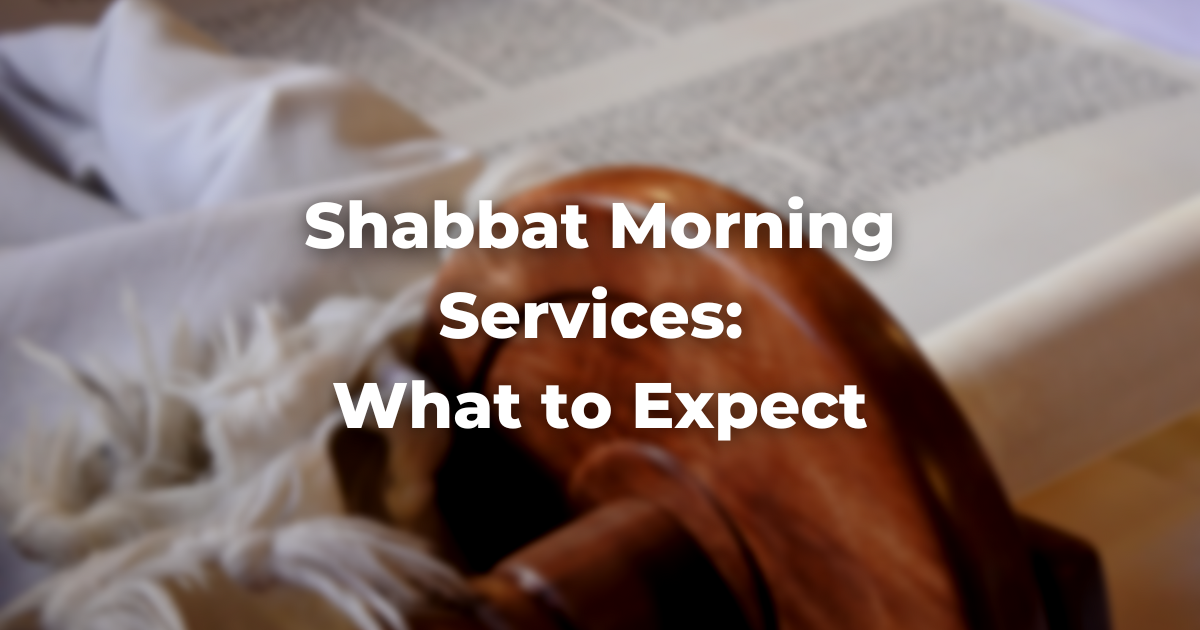For somewhere between two and three hours before noon each Saturday morning, we thank God, spend time in community, sing our hearts out, read some holy texts, and revel in Shabbat rest. If only the Shabbat morning service seemed so simple at first glance!
In order to fully harness the communal and personal beauty of the Shabbat morning service, it can be helpful to come in with a few expectations.
Dress
Although different synagogues embrace different clothing cultures, business casual is always a good middle ground when exploring a new Shabbat community. Most Conservative synagogues will expect men and expect or encourage other genders to wear a kippah or other head covering. Jews who feel comfortable doing so will also wear a tallit, a fringed prayer shawl.
Noise and Movement
While different synagogues have different approaches to chatting during services, first-time Shul-goers are often surprised at some synagogues’ openness to extra noise.
Your first time in a synagogue, feel free to ask the person next to you about what is happening during the service, and expect that someone will come up to you and introduce herself. As services are quite lengthy, you should feel comfortable leaving the prayer space for a moment to get some air or even some freshly brewed coffee.
Many synagogues also encourage kid noises and movements, whether in a designated play space or spread throughout the aisles, as a toddler might use the prayer service as primetime for running practice.
Prayer Basics
Many Jewish communities incorporate two books into their Shabbat morning prayer service – a siddur (prayer book) and a humashA collection of the Five Books of Moses, Pentateuch, or the Hebrew equivalent. Includes the haftarot readings, and usually contains some commentary. It is often used on Shabbat mornings to help follow the Torah reading. Read more (weekly readings from TorahRefers to the first five books of the Hebrew Bible, the Tanakh, also called the Five Books of Moses, Pentateuch or the Hebrew equivalent, Humash. This is also called the Written Torah. The term may also refer to teachings that expound on Jewish tradition. Read more and Prophets). While a large portion of the prayer service is led in Hebrew, most siddurim and humashim will include translations in the local language. Many siddurim will even include transliteration, the Hebrew text written in the letters of the local language.
In communal Jewish prayer services, we use three basic modes of prayer.
We recite some of our words silently or in a quiet mumble, our prayer leader chants or sings some of our words on her own, and we sing some other words in unison. Whenever a melody starts up, even if you don’t know the words, you are welcome to sing along to any syllable that comes naturally – la la la, da da da, etc.
Throughout the prayer service, get ready for a lot of standing up and sitting down. If you are unable to stand up and sit down comfortably, please know that you are welcome to move or stay seated as is healthy for you.
Order of Prayer
While being present for all of the service is a joy, there will most likely be people coming into and out of services the entire time. If you’re not a morning person, don’t despair! In most communities, there will be no judgment if you’re a few minutes, or even more than a few minutes, late.
Prayer services will begin with some combination of Birkhot haShahar (Morning Blessings) and Psukei d’Zimrah (Verses of Song), two poetic warm-ups. Each community practices these sections differently, with some reciting the entirety of both sections in near-silence, some singing excerpts in unison, and others falling somewhere in between.
The energy of prayer begins to intensify as we begin Shaharit (also spelled Shacharit), our formal morning service. The first section of Shaharit explores themes of creation, revelation, and redemption, all surrounding the Sh’ma (also spelled Shema), our central declaration of faith as defined in Deuteronomy 6:4. The second section of Shaharit, our Amidah, gives us time for standing, silent prayer, with a communal lead-in beforehand or repetition afterwards.
While the Amidah can be a wonderful time to delve into the language of our ancestors through words on a page, it can also be a beautiful time to talk to God in our own, individual language.
As early birds and latecomers alike have settled into their seats, the Torah service begins. Here, we read a weekly passage from the Five Books of Moses out of a sacred scroll we call Torah.
Pomp and circumstance surround the Torah reading, with a parade of the Torah scroll, a reading from the book of Prophets (Haftarah), Psalms, and prayers for community, country, and peace. The Torah service gives the Jewish community the opportunity to honor its members, as a leader called the gabbai offers blessings and various ritual roles to individuals and couples in honor of life cycle events, achievements, and remembrances.
At some point during the Shabbat morning service, a rabbi, cantor, or community leader will deliver a d’var Torah, a sermon or teaching, often about the weekly Torah portion. While this particular rabbi presents her d’var Torah before the Torah service begins, other rabbis teach when the Torah leaves the ark or directly after the Torah service. Once the Torah is back in the ark, we continue with Musaf, an additional service that includes one more Amidah, a few more songs, and often, some community announcements.
Food, Glorious Food!
It may be tempting to duck out after multiple hours of prayer, and yet, the best part is soon to come! After we say blessings over wine and bread, many Jewish communities hold a lunch for everyone who was present at services.
The Kiddush lunch is a great chance to meet fellow community members and to ask questions about this particular community’s culture and values. Whether or not a community has extra learning or singing after lunch, it’s often the norm for a few stragglers to become so engrossed in conversation that they stay laughing together in the parking lot for hours after the rabbi has gone home.
Finding Your Place
Each person is drawn to different parts of the Shabbat morning service.
Some find comfort in moments of silence, while others experience release when they sing with raised voices. Some love listening to the rabbi’s perspective on Torah, while others much prefer the conversations they have with friends over Kiddush lunch.
If you experience boredom at one moment, you may experience excitement the next. If one synagogue feels foreign, another may feel like home. Within the vast temporal space of the Saturday morning service, we can enjoy not only our own prayer journey and preferences, but also, learn about others’ relationships to their Judaism, as well.
Are you looking for a Shabbat morning service? Click here to find a synagogue.
Author
-

Rabbi Sydni is originally from Agoura Hills, California. Previously, she served as the Rabbi of Agudath Achim in Shreveport, Louisiana. She has also served as a spiritual leader and teacher at Jewish organizations such as Ohr Shalom Synagogue (San Diego, California), IKAR (Los Angeles), and B’nai B’rith Camp (Neotsu, Oregon). Rabbi Sydni especially enjoys teaching, learning, reading, writing, and chatting about Jewish approaches to self-care, the status of women in Jewish law, and Biblical notions of love of God. When she is not at Congregation Beth Torah, you may find her practicing yoga, playing piano, or enjoying the season's produce. You may also find her spending time with her husband and best friend, Rabbi Feivel, their son Shalom Zimri, and their dogs Buddy and Marbles.
View all posts




